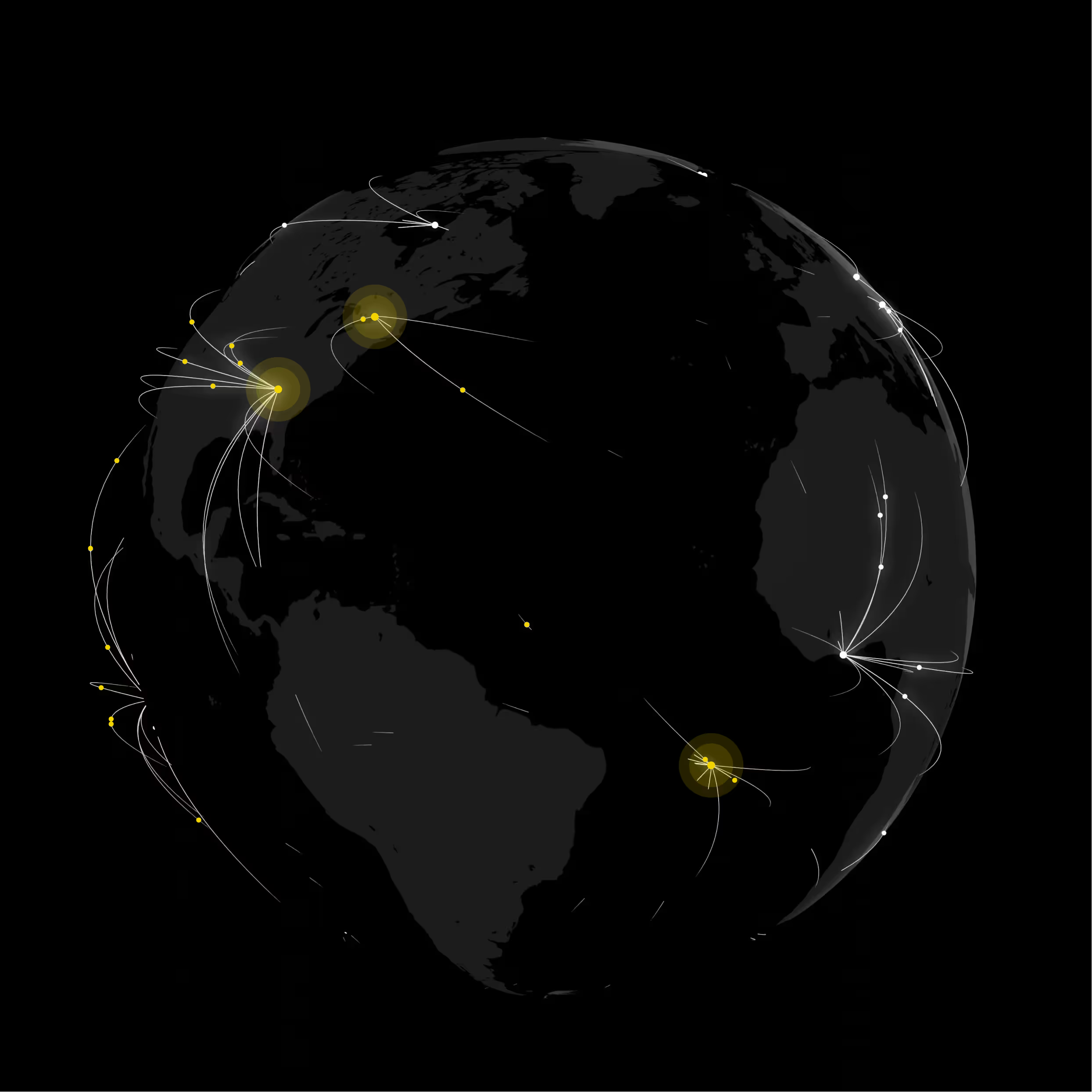Situational Awareness Brief: Middle East Conflict - November 25, 2024
Introduction
The Middle East has been an active conflict zone for over a year, beginning with Hamas’ attack on Israel on October 7th, 2023. The conflict quickly expanded to include Gaza, the West Bank, Lebanon, Syria, Yemen, and Iran. Despite this continuous level of activity, recent events, including Israel’s assassination of Hezbollah leader Hassan Nasrallah and Iran’s firing of 200 ballistic missiles at Israel, have escalated tensions and increased the risk of a hotter and broader regional conflict.
This report summarizes the current threat environment in the Middle East to provide context to security teams with personnel, events, or assets in the region and includes safety recommendations for travelers and U.S. citizens. The terrorist organizations discussed in this piece hold virulently anti-American stances and have illustrated their ability to conduct operations internationally. Therefore, a better understanding of these threat actors can help with domestic security planning and prevention.
Current Situation
Israel is currently engaged in both Gaza (Hamas and Palestinian Islamic Jihad) and Southern Lebanon (Hezbollah), conducting daily strikes from the air and sea, as well as with ground forces. On October 1st, Iran launched a missile strike on Israel, firing nearly 200 ballistic missiles. In response to this, Israel conducted precise strikes against military targets in Iran on October 26th. Outside of hitting critical missile production facilities, Israeli officials have reported striking infrastructure related to Iran’s nuclear program.1
There is uncertainty as to whether these retaliatory attacks will be viewed as sufficient by both countries’ leaders and allow for a detente, or if violence will continue to escalate into outright war. As part of its October 26th air operation, Israel demonstrated its clear air superiority over Iran and its ability to operate effectively within the country’s airspace. This will likely serve as a significant deterrent to further overt Iranian actions.
There is also an element of uncertainty regarding the incoming Trump administration and whether it will press Israel to conclude its operations in Gaza and Lebanon. Although President-Elect Trump is widely viewed as a strong ally of Israel, he also ran on a platform that critiqued the Biden administration’s large-scale military aid to foreign countries (i.e., Israel and Ukraine). His administration likely doesn’t want to inherit a situation that could quickly escalate into an all-out regional war. However, there was also a foiled assassination plot against President-Elect Trump during the summer of 2024 that was orchestrated by Iran’s Islamic Revolutionary Guard Corps. This may impede diplomatic initiatives. Initial reports indicate that Trump will likely revive his previous administration’s “maximum pressure” plan to bankrupt Iran, limiting its ability to fund its nuclear program and bankroll proxy groups (e.g., Hezbollah).2
At the time of reporting, there has been a breaking development in ceasefire talks between Israel and Hezbollah. As of November 25th, Israeli Prime Minister Benjamin Netanyahu has approved a ceasefire deal “in principle.” Israel still has security concerns about the terms, which will be transmitted to Lebanon’s government for further negotiation. Although Israel’s cabinet would have to approve any deal, the Prime Minister’s preliminary approval is a major step forward in de-escalating the conflict. The initial ceasefire would pause hostilities for 60 days while negotiators work on a long-term and lasting agreement. This will also allow the incoming Trump administration to provide its input on any final terms.
Israel’s cabinet is expected to vote on and approve the ceasefire deal on November 26th.
Gaza
After the October 7th, 2023 Hamas terrorist attack on Israel, which claimed the lives of over 1,200 people, Israeli forces have actively engaged Hamas in Gaza, focusing on neutralizing the continued threat posed by Hamas and rescuing hostages taken during the attack.3 While Hamas’ capabilities have been severely degraded by Israeli forces and many key leaders have been killed over the past year (including Ismail Haniyeh, Hamas’ Political Bureau chair), it still maintains operational capabilities. This includes firing rockets into Israel (at least 35 were fired from Gaza into the country during October 2024).5 Of the 251 hostages taken on October 7th by Hamas, 97 remain in captivity. There are an additional four hostages that were taken before the October 7th hostages, bringing the total to 101.6
On October 17th, Israeli officials confirmed that they killed Yahya Sinwar the previous day during a routine military mission.7 Sinwar was the leader of Hamas in Gaza from February 2017 until his death, and a key architect in the 10/7/23 terrorist attack on Israel. Following the assassination of Ismail Haniyeh in July 2024, Sinwar also headed Hamas’ political bureau.
Sinwar’s death could serve as a significant milestone in the Israel-Hamas war. With its senior leadership decimated, Hamas’ remaining leaders may be more amiable to a ceasefire. US officials viewed Sinwar as a major impediment to peace negotiations and his death may end the deadlock between Hamas and Israeli negotiators.8 There is, however, no consensus among analysts as to whether Sinwar’s death will hasten a conclusion to the conflict.8 However, his loss will likely impact Hamas’ strategic plans and fighting efficacy. As of November 20th, the IDF has claimed to have killed 8 brigade commanders, 30 battalion commanders, and 165 platoon commanders.10 Nearly 17,000 Hamas operatives were also eliminated, reflecting a major loss in the organization’s personnel.11 12
West Bank
Readers are advised that Israel has also eliminated at least 700 militants in the West Bank, as of November 21st, since the start of the war.13 Although the IDF has not conducted operations in the West Bank of the same scale and nature as those in Gaza, there have still been several tactical airstrikes and special operations missions. There has also been continuous unrest in the area (including East Jerusalem) since October 7th, 2023. This includes elevated levels of settler violence against Palestinian civilians, as well as terrorist attacks directed at Israeli security personnel and border police. Therefore, it is strongly advised against visiting or traveling through the West Bank.
Lebanon
Tensions between Israel and Hezbollah have been steadily growing since October 7th, 2023. On October 8th, 2023, immediately following Hamas’ attack on Israel, Hezbollah fired upon Israel from Lebanon in solidarity with Hamas.14 Since then, Israeli Defense Forces (IDF) and Hezbollah have continued to strike each other along the border on an almost daily basis. Beginning in September 2024, Israel pivoted its focus towards its border with Lebanon, executing a special operation resulting in the explosion of Hezbollah-issued pagers and walkie-talkies and then launching Operation Northern Arrows against Hezbollah on September 23rd.
The border conflict before Operation Northern Arrows led to the displacement of 110,000 Lebanese from Southern Lebanon and 60,000 Israeli civilians from Northern Israel, respectively, and these figures have continued to grow.15 As of November 18th, 143,000 Israelis have been internally displaced across the country due to Hamas and Hezbollah activity.16


As part of this recent campaign, Israel has stepped up the volume and intensity of its attacks on Hezbollah, targeting key leaders, as well as its large cache of rockets and missiles throughout Lebanon. In early October, Israel sent ground forces into Southern Lebanon with the stated goal of pushing Hezbollah north of the Latani River.
Readers are advised that the Lebanese military and its government have largely avoided conflict with Israel and Hezbollah. There are fears within the Lebanese government that if its military were to engage Hezbollah, a civil war would erupt as the terrorist organization holds enormous sway over Lebanese politics and society. Additionally, there are concerns that the military is poorly situated to enforce any ceasefire terms and monitor Hezbollah due to a lack of resources and willingness to engage the organization.18 This complicates the peace process as it is unlikely that Lebanon would also be amendable to a long-term Israeli military presence within the country. However, there is little confidence that the Lebanese government can effectively contain Hezbollah without international assistance and external forces.
Iran
Iran is a state-sponsor of multiple terrorist actors in the region, including Hamas, Hezbollah, and the Houthis. This network of terrorist groups is often referred to as the “Axis of Resistance,” as it aims to limit US and Israeli influence in the Middle East. The Islamic Republic provides money, weapons, and training with the strategy of surrounding Israel. This is mainly accomplished via Iran’s Islamic Revolutionary Guard Corps (IRGC); a multi-service military branch that holds enormous political and economic power within Iranian society. Outside of conventional military tasks, the IRGC also conducts espionage, engages in cyber attacks, and provides support to terrorist actors. This support includes arms, financing, training, and on-site advisors.
On July 31st, Israeli personnel were able to assassinate Ismail Haniyeh, the political leader of Hamas, in a military guesthouse in the Iranian capital of Tehran. The incident served to both warn and embarrass the Iranian regime and its security forces while at the same time eliminating one of Israel’s most important foes.
Recent Events Involving Israeli Internal and International Security
Outside of the Middle East, Israel has been contending with broader threats to its citizens traveling aboard. Additionally, there have been continued security challenges and flare-ups of unrest within its borders. Some recent developments include:
November 21st - A Rabbi with dual Israeli-Moldovan citizenship was kidnapped and murdered by the IRGC inside the United Arab Emirates. It is recommended that Jews and Israeli citizens exercise extreme caution in the UAE. Avoid gatherings at obvious Jewish/Israeli locations or wearing any easily identifiable items or clothing.
November 19th - Over 1,000 arrest warrants were issued in Israel for members of the ultra-Orthodox Jewish community (or Haredi community) that did not respond to draft orders.20 Readers are advised that there have been related protests in Israel since the Israeli Supreme Court ruled in June 2024 that Haredi men were not exempt from military service.
- Large gatherings can be ideal targets for threat actors that wish to inflict mass casualties. Additionally, Israeli cities have been repeatedly targeted by Hezbollah, Houthi, and Hamas rockets. In October 2024 alone, there were 4,735 rocket launches from Gaza, Lebanon, and Syria into Israel.21 Extraordinarily large crowds can cause congestion and prevent people from reaching bomb shelters in time.
- There have also been repeated protests, demonstrations, and vigils in Israel in support of the hostages held by Hamas and a ceasefire deal that would secure their immediate release. This unrest has been catalyzed recently by Prime Minister Netanyahu’s dismissal of Israeli Defense Minister Yoav Gallant. Gallant is a popular figure in Israel and was a strong proponent of rapidly securing a hostage deal.22 His dismissal has also been criticized as reckless due to Israel’s ongoing conflicts, which would benefit from continuous seasoned leadership.
- Although these protests have largely been peaceful in nature, some have had a strong anti-government sentiment. On November 16th, for example, three prominent protestors were remanded for firing flares at Prime Minister Netanyahu’s home in Caesarea.23

November 12th - The Israeli government warned Israelis and Jews in Thailand that Thai police had firm indications of a terrorist plot against the November 15th Full Moon party on the island of Koh Phangan.24 Israeli citizens and Jewish persons were advised to avoid wearing anything that would highlight their identity, as well as to avoid any gatherings associated with Israelis or the Jewish community.
- This followed a severe travel warning for Israelis in the Arugam Bay area (Sri Lanka) that was initiated in October after an Afghani national was arrested in the US and revealed to the FBI that he had been ordered to conduct a mass shooting in the area.25 The arrestee had been recruited by Iran’s Islamic Revolutionary Guard Corps.
November 11th - Two Israelis were injured when a Palestinian man rammed a security checkpoint in the town of al-Khader (West Bank) while IDF personnel were operating in the area.26 The suspect was able to escape and is still being sought.
November 7th - Riots broke out before and after a soccer match in Amsterdam between Maccabi Tel Aviv and Ajax Amsterdam. The exact timeline of how the riots precipitated is still being established.27 Current reports indicate that racist chants, the destruction of Palestinian flags, and the vandalism of taxis by Maccabi fans created outrage among parts of the city’s Muslim population, who have been contending with longstanding institutional and systemic issues in the Netherlands. This flashpoint escalated into anti-semetic violence, not just against Maccabi fans, but also Dutch Jews and Israelis who were subjected to hit-and-run attacks and acts of intimidation (e.g., being forced to present their passport or answer questions about their nationality).28 There were also social media posts discussing a “hunt on Jews.”29
- The Israeli airline El Al launched a series of emergency flights to evacuate 2,000 Israeli citizens from the Netherlands.
- In response to the riots, Amsterdam banned protests for three days under emergency measures.30 During the violence, police were pelted with rocks and a tram was set ablaze.
- Community leaders have raised concerns that although the riots have ceased, there may be future unrest due to unresolved issues of antisemitism, Islamophobia, and xenophobia in Dutch society.31
October 27th - A truck ramming attack killed one person and injured 32 others at a bus stop in Glilot, north of Tel Aviv. Many of those injured were elderly persons on a day trip. The bus stop was in close proximity to Mossad and Israeli intelligence buildings.32
Threat Actors Overview
Hezbollah
Hezbollah is a Lebanese-based Shia Islamist group with both political and military arms. Founded in 1982 in the model of Iran’s Islamic revolution, Hezbollah’s stated aims are to destroy Israel and rid the Middle East of Western involvement. Although the group began as a rogue organization within Lebanon, it now has more formally integrated into Lebanese society, holding 15 seats in Lebanon’s Parliament.
Hezbollah is considered to be the largest non-state military actor worldwide. Backed by Iran, they have amassed an arsenal of tens of thousands of rockets and missiles and claim to have over 100,000 fighters in their ranks. In violation of UN Security Council resolution 1701, Hezbollah has heavily fortified Southern Lebanon’s border with Israel with weapons, personnel, and subterranean bunkers and tunnels. In recent years, the terrorist group has developed combat experience through its involvement in the Syrian civil war.33
Hezbollah acts as a “state within a state,”34 often providing social services as a means of solidifying political support in Lebanon and legitimizing its terrorist operations. This is akin to how organized crime groups often entrench themselves within communities. The organization is heavily backed and funded by Iran. Iran’s Islamic Revolutionary Guard Corps was critical to the formation of Hezbollah, providing funds, advisors, and training to the group as it formed in the late 70’s and early 80’s.35 As Israeli operations continue against Hezbollah, tensions with Iran will also escalate due to these established and any IRGC personnel embedded with Hezbollah commanders are at an extremely high risk of being killed by IDF airstrikes (which would incense Iran further).

In 1983, Hezbollah orchestrated the bombings of the US embassy in Beirut and barracks housing both French and American marines. Combined, these bombings killed 368 people. One of Hezbollah’s core goals is to eliminate Western presence within the Middle East. Continued US political and military support for Israel has increased the organization’s hostile views towards Americans. Although Hezbollah is currently distracted by increased IDF activity and the decimation of its command staff, it may consider high-profile attacks as a means of restoring its reputation after a string of defeats.
Readers are cautioned that Hezbollah operatives operate outside of Lebanon and have even had a presence on US soil.36 A recent US intelligence threat assessment states that Hezbollah “maintains the capability to target U.S. persons and interests in the region, worldwide, and, to a lesser extent, in the United States.”37
- In 2017, one operative was arrested in New York after surveilling law enforcement and military sites.38 Another operative, later within the same year, was arrested in Detroit after investigating the availability of explosives for use on the Panama Canal. Said operative was also believed to have surveilled both US and Israeli sites.
- In April 2014, two operatives were arrested in Bangkok (Thailand) while planning to attack Israeli tourists.
- In 2012, Hezbollah operatives bombed a bus in Burgas, Bulgaria. The attack killed five Israeli tourists and their Bulgarian bus driver.39
- On July 18th, 1994, Hezbollah operatives in Buenos Aires (Argentina) conducted a bomb attack against the Asociación Mutual Israelita Argentina (AMIA) Jewish community center. The attack killed 85 people and injured over 300.40 41
- On March 17th, 1992, the Israeli embassy in Buenos Aires was bombed. The suicide attack killed 29 people and injured 242 others. Although the Islamic Jihad Organization took credit for the attack, Hezbollah operatives were later charged with orchestrating the attack.42 Argentinian courts have also alleged that Iran was heavily involved with both the 1992 and 1994 bombings.43
Recent Events Related to Lebanon and Hezbollah
Israeli infantry advances into Hezbollah-controlled territory have frequently uncovered stockpiles of Russian-manufactured weaponry, including advanced anti-tank ordnance.44 Both Hezbollah and Russia fought on the same side during Syria's civil war. Russia is also a strategic and military ally of Iran. Although the presence of Russian weaponry was expected by Israeli forces, they have been far more extensive than initially estimated. Russian weapons constituted nearly 60 to 70 percent of the arms recovered during the initial wave of Israeli ground operations.45
November 4th - The IDF confirmed that it conducted a successful airstrike against a Hezbollah intelligence unit in Syria.46 Israel has conducted strikes in the country since 2011 to prevent weapons transfers between Iran and Hezbollah, as well as limit both Iran and Hezbollah’s presence in the war-torn region.
October 30th - US diplomatic envoys arrived in Lebanon to facilitate peace talks between Hezbollah and Israel.47 Lebanon's prime minister expressed optimism that a ceasefire is achievable and imminent.
- On November 20th, the US special envoy expressed that progress has been made regarding ceasefire talks.48 However, Israeli negotiators want the freedom to respond to violations against ceasefire terms (i.e., military operational freedom),49 while Hezbollah doesn’t want its nationwide political aspirations to be limited.
- Although it appears, as of November 25th, that an initial ceasefire will likely be approved by both parties, there is still a possibility that talks could deteriorate again. The situation is still developing and readers are advised to frequently check trusted media sources.
October 29th - Hezbollah’s media office reported that Naim Qassem, a Shiite cleric, was elected by the group’s Senior Council as the replacement for Nasrallah.50 Qassem helped found Hezbollah and has served as its deputy secretary-general since 1991.
October 28th - Israel’s parliament adopted a measure to ban UNRWA (United Nations Relief and Works Agency for Palestine Refugees in the Near East) from operating within Israel. UNRWA was founded to provide human development and relief services to Palestinians.
- The organization has been heavily criticized due the presence of Hamas operatives within its ranks and the involvement of its employees in the October 7th terrorist attacks, as well as the redirection of aid to Hamas.
- In September, UNRWA received further criticism when it was revealed that a Hezbollah commander killed in an Israeli strike was also an UNRWA worker.
- The move has resulted in an international backlash against Israel, which has responded that there are alternatives to UNRWA and that it is committed to ensuring that humanitarian aid will continue to flow into Gaza.
October 26th - Over 100 Israeli aircraft conducted strategic strikes against Iran in response to Iran's second missile barrage against Israel on October 1st. The strikes targeted missile production systems in Iran, air defense infrastructure, and other military sites. At least four Iranian soldiers were killed. The strikes illustrated Israel’s ability to conduct large-scale air operations in Iranian airspace, as well as the extensiveness of Israel’s intelligence on Iran.
October 13th - A Hezbollah drone struck Binyamina, a town in northern Israel, injuring over 60 people. The IDF is investigating how the drone evaded detection and interception measures. Four IDF soldiers were also killed during this attack.
- On the same day, it was reported that the US would deploy advanced anti-missile systems to Israel, as well as 100 soldiers to operate them, to help protect against possible Iranian missile attacks.
- Another notable incident on the 13th was the entrance of Israeli tanks into a UN peacekeeping base. The IDF states that it was a last resort to evacuate wounded soldiers injured by an anti-tank missile. The UN forces, however, portrayed it as an act of antagonism after the base refused to turn off its lights.
- Israeli Prime Minister, Benjamin Netanyahu, has repeatedly asked the UN to evacuate its peacekeeping force, stating that UN peacekeepers are being used as “human shields” that Hezbollah uses to its advantage by launching attacks in proximity to UN positions (which limits how the IDF can respond). At the time of reporting, the UN has denied the Prime Minister’s requests.
September 27th - Israeli Defense Forces (IDF) successfully eliminated Hassan Nasrallah, secretary-general of Hezbollah. This, combined with Israeli strikes within Beirut and ground IDF operations within Lebanon, has greatly weakened Hezbollah’s capabilities and command structure.
- In response to Nasrallah’s neutralization, Iran launched a barrage of approximately 200 ballistic missiles at Israel. The attack was largely ineffective due to US and Israeli countermeasures (e.g., the Iron Dome), but claimed the life of one Palestinian in Jericho. It also failed to disrupt Israeli air operations in the area. There was significant private property damage across Israel, though, totaling up to $53 million USD.
- Tensions with Iran have also escalated due to the killing of Ismail Haniyeh, chairman of Hamas’ political bureau, on July 31st.
- Minutes before the Iranian missile attack began, two Palestinian men from Hebron committed a mass shooting in Tel Aviv. The attack killed 7 people and left 16 injured.
September 17th and 18th - Israel launched a sophisticated and highly advanced remote attack by detonating explosives embedded in pagers and walkie talkies utilized by Hezbollah personnel.
- The blasts injured approximately 3,000 people and killed at least 37.
- Israel’s Mossad and Shin Bet are believed to have laced the devices’ lithium batteries with the explosives, making them difficult to detect within the casing.
- Details regarding the attack are still developing and it remains uncertain where Israeli intelligence personnel were able to infiltrate the supply chain of the devices.
July 27th - A Hezbollah rocket struck a soccer field in the town of Majdal Shams, located in the Golan Heights (Northern Israel). 12 Druze children were killed by the explosion, and over 30 more people were injured. The Druze are an ethno-religious minority group among Israel’s Arab citizens.
- Although Hezbollah denied attacking the town, forensic evidence indicates that the weapon was an Iranian Falaq-1rocket, which is exclusively used by Hezbollah.

Yemen and the Houthis
Since October 7, 2023 the Iranian-back Houthis have launched multiple missile attacks against Israel, while Israel has retaliated with airstrikes. Following two days of Houthis missile attacks on Israel on September 27th and 29th, Israel attacked the Houthis in Yemen on September 29th, targeting the port city of Hodeidah and a power plant. The Houthis frequently attack Israel and international shipping vessels in the Red Sea as an act of solidarity with Palestine. They are a Specially Designated Terrorist Group, as well as a rebel force challenging Yemen’s government. Outside of these terrorist and rebellion activities, the Houthis are known for engaging in piracy.
The Houthis began coalescing during the 1990s. As a Zaydi Shiite group, it formed in part as a resistance to Yemen’s Sunni-majority government and Saudi Arabian influence in the area (Saudi Arabia is largely Sunni Muslim). Also at the core of the Houthis’ ideology are extreme anti-American and anti-Israeli views. Part of the group's flag translates to “death to the USA, death to Israel, curse the Jews.”
The group receives support in the form of arms, drones, and advisors from Iran’s IRGC. A Congressional Research Service report assesses that “Houthi military capabilities include ballistic missiles, cruise missiles, rockets, and unmanned aerial and underwater/surface vehicles, in addition to conventional and unconventional air and ground forces. With this support, the Houthis act as a proxy for Iran and commit attacks on behalf of Iran’s regime. The Washington Institute assesses that Iran “can now exploit new opportunities by cooperating with other axis players in Iraq as well as with Russia, potentially offering Yemen as a platform from which Iran can deploy advanced weapons against Israel and the West without drawing direct retaliation…”
Recent events related to the Houthis
November 14th - It was reported that Under Secretary of Defense for Acquisition and Sustainment Bill LaPlante (aka “the Pentagon’s chief weapons buyer”) expressed shock at the weapons that the Houthis have deployed and their level of sophistication.
November 13th - Houthi officials stated that they struck a “vital target” in the Israeli port city of Eilat. The previous day, the group launched an hours-long attack against two US warships with missiles and drones. The attacks were successfully repelled by the USS Stockdale and USS Spruance without injury or damage.
November 9th and 10th - The US military conducted strikes on multiple Houthi stockpiles in Yemen containing “advanced conventional weapons.” These strikes involved the first combat use of the F-35C, a state of the art long-range stealth strike fighter, which was able to effectively operate in Houthi-controlled airspace.
October 29th - The Houthis launched a drone at an industrial area in Ashkelon (Israel). The drone, however, fell into an open area before reaching its target.
Mid-October - It was reported that Russia was providing the Houthis with targeting data (e.g., satellite imagery) to assist the group’s piracy activities.
October 10th - The Houthis struck a Liberian-flagged chemical tanker in the Red Sea. Since October 23rd, Houthi rebels have targeted over 80 vessels in the Red Sea, specifically targeting those with ties to Israel, the US, and the UK.
October 4th - U.S. forces struck 15 Houthi targets in Yemen to limit the terrorist group’s offensive capabilities. The strikes were conducted, in part, as a response to a recent Houthi attack against US naval vessels that involved cruise missiles and drones (all of which were intercepted). The U.S. and its international partners, such as the UK and Israel, have been consistently engaging Houthi threats in the Red Sea since 10/7/23 to protect vital shipping lanes and civilian vessels.
October 7th - The terrorist group fired two missiles at Jaffa (Israel) that were intercepted by the IDF.
July 19th - A Houthi drone struck an apartment building in Tel Aviv on July 19th, killing one person and injuring four others. The apartment building was located near the US embassy. The drone was a long-range Iranian model. Like Hezbollah, the Houthis are backed by Iran’s regime.
An analysis of historic Houthi drone use, produced by ACLED, can be found here.
ISIS
Throughout 2024, ISIS (the Islamic State of Iraq and Syria) has resurfaced as a prominent terrorist threat to the international community. After losing its last stronghold (Baghouz, Syria) in March 2019, ISIS hasn’t been able to reclaim the territory or conventional military power it once had. Where its threat lies is its effective use of propaganda and social media to influence disaffected people across the world and inspire them to commit attacks. This includes leveraging mainstream platforms such as Tik Tok, not just obscure forums or encrypted messaging services (e.g., Telegram). In addition to propaganda, ISIS also provides guidance on conducting attacks through manuals. This includes maximizing casualties and the impact of an attack through easily accessible means (e.g., renting a moving truck to drive into crowds). Altogether creates enormous difficulties for law enforcement and security personnel as ISIS can prompt people to act on their behalf with limited or no direct contact.
The terrorist network has at least 19 branches across multiple continents, as well as covert cells, making it difficult to contain and eliminate. After the Taliban’s retaking of power in Afghanistan, Western intelligence agencies and militaries have had limited efficacy in countering and infiltrating terrorist groups in the country and its borderlands. Because of this, the Khorasan branch of ISIS ( aka ISIS-K) established a stronghold in the eastern part of the country along the border of Pakistan. It is quickly becoming the most feared and effective branch of the terrorist network. Perhaps most notably, it committed an attack on the Crocus City Hall in Moscow (Russia) in March 2024 that killed over 130 people.
Readers are encouraged to read previous Base Operations threat assessments for additional information on ISIS activity earlier in 2024. These assessments are linked below:
- Safe Celebrations: Pride 2024
- Safe Celebrations: 2024 Paris Olympics and Paralympics
- Security Assessment: 2024 Republican & Democrat National Conventions
- Security Assessment: 2024 United Nations General Assembly
Recent ISIS-related events
November 20th - Law enforcement in Illinois observed an ISIS-K graphic that promised to make the Christmas season “Miserable.” The image depicted a grenade as a Christmas ornament, with a camouflaged figure holding a rifle in the backdrop. Readers are advised that ISIS operatives or sympathizers may view large-scale holiday gatherings as attractive targets due to the presence of crowds and their symbolic weight and or religious significance.
November 14th - A 28 year-old was indicted in Houston (Texas) for providing material support to ISIS. The suspect, Anas Said, offered his home as a safe haven for ISIS operatives, as well as hoped to join the US military so that he could commit an attack internally. He also assisted the organization through graphic design work for its propaganda.
October 29th - Israeli Police and Shin Beit reported that a Umm al-Fahm resident (Haifa District of Israel) was arrested on suspicion of plotting a terrorist attack on behalf of ISIS.
October 10th - Israeli police and Shin Bet issued a joint statement that an ISIS-linked plot had been foiled. Five Arab-Israelis with ties to the terrorist group were allegedly planning a bomb attack against a popular shopping mall in Tel Aviv.
October 8th - An Afghan national living within the US was arrested in Oklahoma for allegedly plotting an Election Day attack on behalf of ISIS.
- After an initial interview with law enforcement, the subject confirmed: “confirmed that the attack was intended to target large gatherings and that he was expected to die a martyr along with a juvenile co-conspirator, described as an Afghan citizen with legal permanent resident status.”
- The subject’s internet history indicates that he was trying to purchase firearms without a permit and also access cameras within Washington, DC.
- Readers are advised that many major cities make traffic camera feeds available to the public. This can be a security concern as numerous cameras are placed at critical intersections.
October 6th - It was reported that Tajikistani nationals arrested in the US with alleged ties to ISIS were being deported back to Tajikistan. The subjects were arrested in late June, 2024. Deporting the suspects, rather than pursuing a lengthy trial, was seen as a resource saving move by the Department of Justice.
October 4th - It was reported that the IDF freed a Yazidi woman in Gaza who had been kidnapped by ISIS in northern Iraq in August 2014.
- August 2024 marked the 10th anniversary of the beginning of ISIS’s genocidal campaign against the Yazidi people, which led to widespread killings, enslavement, and trafficking of the community.
- There are an estimated 44,000 Yazidi women and children still held in detainment camps in Northeast Syria. After ISIS lost much of its territorial control in 2019, many of the group’s trafficking victims were wrongfully detained alongside their captors.
September 29th - It was reported that US airstrikes in Syria killed 37 affiliates of ISIS and al-Qaeda. Among the eliminated terrorists were two senior leaders; however, their names have not been disclosed.
September 4th - A Pakistani national residing in Canada was arrested for allegedly plotting a mass casualty attack on the Jewish center in Brooklyn. The subject allegedly planned to conduct the attack in the name of ISIS on October 7th or October 11th (Yom Kippur).
Recommendations
Despite the strong possibility of a ceasefire, readers with personnel in Lebanon are recommended to evacuate personnel along the border with Israel and Beirut, as well as any area with a significant Hezbollah presence. The organization has the heaviest control over “parts of Beirut, southern Lebanon, and the eastern Bekaa Valley region.” A temporary pause in the conflict will be an ideal time to relocate personnel and reevaluate security measures.
Readers are also cautioned that Lebanon only has one major airport and flights out of the country may be severely scarce. The single airstrip may also be prioritized for aircraft carrying aid and essential supplies.
- The US has made arrangements to increase the number of flights out of Lebanon and even prepared military options to evacuate citizens.
- Israel has stated that it’s committed to avoiding any strikes that may impact Lebanon’s Beirut-Rafic Hariri International Airport or major ports. However, it should be noted that Hezbollah (like Hamas) is known for using both civilians and critical infrastructure as shields. The IDF may have to strike those areas from which Hezbollah is launching attacks.
- Middle East Airlines has received acclaim for operating consistently through the conflict, only reducing its number of daily flights slightly.
EASA (the European Union Aviation Safety Agency) initially advised European airlines to avoid Israeli and Lebanese airspace due to increased military activity. Outside of the risk of being accidentally hit by ordinance, aircraft can be susceptible to various forms of electronic warfare (e.g., GPS or communications jamming) that could lead to navigation errors.
- Although it was reported that the EASA guidance on Israeli airspace was lifted on October 9th, Delta Airlines announced on October 15th that it would suspend flights between JFK and Tel Aviv until March 31st. KLM has also canceled flights to Tel Aviv until the end of 2024.
Readers with personnel in Israel are advised of the increased risk of terrorist attacks, such as the recent mass shooting in Tel Aviv. Any persons traveling through Israel are advised to know where the closest bomb shelter is at all times. At the time of reporting, Google Maps allows users to search for the nearest bomb shelter across Israel.
Israel also has several applications for rocket alerts:
Readers are cautioned that fake alert applications have been established to steal information and download malicious software. Please always vet any downloads or applications before installing them.
For US citizens traveling within the Middle East, it’s advisable to:
- Sign up for the US State Department’s Safe Traveller Enrollment Program. This will allow you to receive real-time updates about an array of emergency conditions, as well as better situate a US embassy or consulate to contact or locate you.
- Regularly consult local and trusted news sources before leaving your accommodation.
- Purchase travel insurance that covers emergency medical care.
- Carry and conceal emergency cash (but not so much as to arouse suspicion).
- Avoid large gatherings and demonstrations.
- Dress casually and modestly. Avoid any clothing that might draw attention to yourself or signal your nationality (e.g., baseball hats or paraphernalia with American flags).
- Carry a power bank for your phone, as well as a universal charger in case you need to travel indirectly across multiple regions unexpectedly. Be sure to invest in a high-quality reliable brand.
- Secure your passport at all times and take a photo of the identification page in case of damage or theft.
- Investigate your accommodations thoroughly. Some hotels, although reputable, carry significant symbolic weight or are associated with Westerners. This may lead to an increased risk of terrorism (e.g., the 2003 Marriott Hotel bombing in Jakarta and 2008 Marriott Hotel bombing in Islamabad) or counterintelligence operations (e.g., room buggings).
- Arrange your transportation to and from airports ahead of time.
- Leave a copy of your itinerary with a trusted person. Also set up established check-in times and maintain regular contact with family, friends, and or responsible colleagues.
- Be aware that terrorists sometimes deploy low-tech means of attack, such as knives and vehicles, and to be on the lookout for suspicious activity at bus stops, static checkpoints where soldiers are stationed, and any large gathering areas. When possible, walk or wait behind anti-ramming barriers.
- Visitors to Israel should know the location of the shelter or safe room in every hotel or building.
Please note: This conflict is continuously evolving. After reading this report, readers should regularly check verified and reliable news sources for the most up-to-date information.
Footnotes
- Israel hit part of Iran nuclear programme, Netanyahu says
- Donald Trump's 'Maximum Pressure' Iran Plan Laid Out - Newsweek
- Anniversary of October 7th Attack - United States Department of State
- https://www.cnn.com/2024/11/25/middleeast/israeli-prime-minister-approves-lebanon-ceasefire-deal-in-principle-intl?cid=ios_appI
- Israel and Lebanon on cusp of ceasefire deal, officials say
- Swords of Iron: an Overview | INSS
- Hamas hostages: Stories of the people taken from Israel
- Live updates: Israeli military investigating whether Hamas leader Yahya Sinwar was killed in Gaza | CNN
- Biden: Sinwar’s death injects uncertainty — but also an opening — into possibly resolving Gaza conflict | CNN Politics
- Analysis: Why Sinwar’s death does not mean a breakthrough in the Israel-Hamas war | PBS News
- Swords of Iron: an Overview | INSS
- Ibid.
- Estimates on the pre-war size of Hamas range from 20,000 to 40,000 personnel. Israeli estimates are more conservative, putting the figure between 20,000 and 30,000.
- https://infogram.com/1p32e9zq0mxgn3t0ypzwzm5pyeud6nd2l2l
- Israel, Hezbollah exchange artillery, rocket fire | Reuters
- Escalating to War between Israel, Hezbollah, and Iran
- Swords of Iron: an Overview | INSS
- Squeezed by Hezbollah and US, Lebanese army would struggle to implement truce - sources | The Times of Israel
- https://www.cnn.com/2024/11/23/middleeast/israeli-missing-uae-dead-intl-latam/index.html
- Israel issues more than 1,000 arrest warrants for ultra-Orthodox draft avoiders | CNN
- https://www.inss.org.il/publication/war-data/
- Israel's Netanyahu dismisses his defense minister as wars rage. Protests erupt across country | AP News
- Shin Bet chief says firing of flares at Netanyahu's home 'far from legitimate protest' | The Times of Israel
- Israel warns citizens in Thailand to be vigilant amid 'growing fear' of terror plots
- Israel removes severe travel warning for Sri Lanka beach town
- Two Israelis injured in Palestinian ramming attack at West Bank checkpoint | The Times of Israel
- Amsterdam violence: what to know about antisemitic attacks, Maccabi fans' chants
- Amsterdam warns of new calls for unrest after violence around Israeli soccer match | AP News
- How a toxic mix of antisemitism, racism and xenophobia culminated in Amsterdam violence | CNN
- https://www.cnn.com/2024/11/07/europe/israel-soccer-fans-attacked-amsterdam-intl-hnk/index.html
- How a toxic mix of antisemitism, racism and xenophobia culminated in Amsterdam violence | CNN
- One dead, 32 wounded in suspected terror truck-ramming at bus stop north of Tel Aviv | The Times of Israel
- https://www.cfr.org/article/syrias-civil-war
- https://www.cfr.org/backgrounder/what-hezbollah
- Ibid.
- https://www.dni.gov/nctc/groups/032004_Hizballah_Activity-Interactive-NCTC/index.html#/
- Lebanese Hezbollah
- Hizballah Operative Sentenced to 40 Years in Prison for Covert Terrorist Activities on Behalf of Hizballah’s Islamic Jihad Organization | United States Department of Justice
- Bulgaria court convicts two over 2012 Burgas bus attack on Israelis
- Statement by Secretary Blinken On the 30th Anniversary of the AMIA Terrorist Attack - U.S. Embassy in Argentina
- 30 years later, a 'push for justice' over Argentina's Jewish center bombing
- Treasury Designates Hizballah Operatives and Financial Facilitators in South America and Lebanon
- Argentina court blames Iran for deadly 1994 bombing of Jewish center
- Israel Finds Large Troves of Russian Arms in Hezbollah’s Hands - WSJ
- IDF finding far more Russian arms in Hezbollah's possession than expected - report | The Times of Israel
- IDF strikes Hezbollah's intelligence unit in Syria, issues rare confirmation | The Times of Israel
- Live Updates: US officials head to Middle East in ceasefire push | CNN
- US envoy to travel to Israel in bid to seal Hezbollah ceasefire | Reuters
- US envoy arrives in Beirut, raising hopes for Israel-Hezbollah ceasefire deal
- Naim Qassem: Hezbollah names a new leader to replace Nasrallah. Here’s what we know about him | CNN
Takeaways

Join 1100+ security leaders getting new ideas on how to better protect their people and assets.







